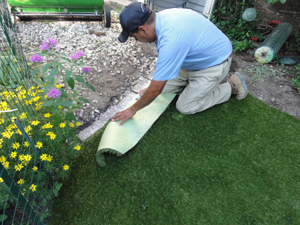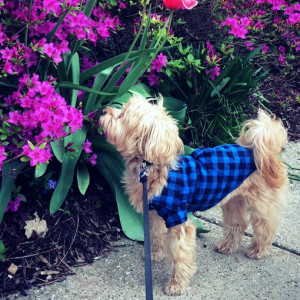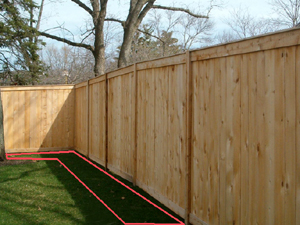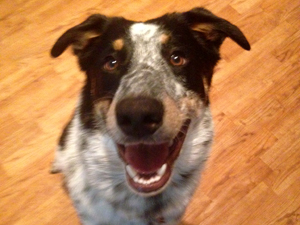You spend a lot of time planning your ideal outdoor space. You make sure to include all of your must-haves like a sitting area, lush landscaping, an area for the kids and maybe even a fire pit or water feature. Don’t forget to also plan for the furry member (or members) of your family, who will be spending time with you in your backyard too. We find these planning tips helpful:
Install paths to run & patrol: Dogs need exercise, and you’d rather have them running around outside than in your house, right? Keeping a 2-to 3-foot border along the perimeter fence should be sufficient for most dogs. Leave this space empty with wood chips or gravel and it will create a space for them to patrol the yard and not harm your plants. If they have already created their own paths, it may be easier to work with these and plant around them.

We installed artificial turf for a client’s entire backyard. A substantial gravel base aids with drainage. Wire fencing around plantings keeps dogs out.
Designate a proper area to answer nature’s call: This space should be easily accessible from the back door, as you’ll be letting Fido out year-round, not just when you’re outside during warmer months. The area could be as simple as a 3-foot by 10-foot area along the side of your house, mulched with gravel or finely shredded bark (stay away from cocoa mulch, which is harmful to dogs). Artificial turf is another solution that is attractive and low-maintenance, with a substantial gravel base that facilitates good drainage. Whatever surface you decide, be consistent in guiding your dog to this area to use the bathroom. Depending on the age of your dog, it may take a few weeks or longer to train him.
Plant wisely: Many commonly used landscape plants may be harmful to dogs (if ingested in large amounts). Baneberry or Doll’s Eyes, for example, is a perennial with striking white berries attached to bold red stems– but all its parts are poisonous. Take some time to research plants that are already in your garden, as well as plants you’re thinking of adding to it. You can refer to the ASPCA website, which offers a list of toxic- and non-toxic plants for general reference. If your dog must be kept out of planting beds, install a fence appropriate to his size and strength.
Opt for natural lawn and garden applications: There are chemical-free lawn and garden applications and fertilizers that are safe around humans and pets. One company, Gardens Alive, promotes all-natural products for the home and garden. A trade-off with non-chemical applications is that while your garden will not be immaculately weed-free, it will be more environmentally friendly.
Keep fleas and ticks away: Keep your lawn mowed regularly as flea eggs, larvae and pupae live in taller grass. In shady, moist, leafy areas, ticks wait for victims to brush past to latch onto them. Protect your dog with flea and tick control in the form of once-a-month topically applied products, sprays, shampoos and oral products. This will assure coverage wherever he goes.



